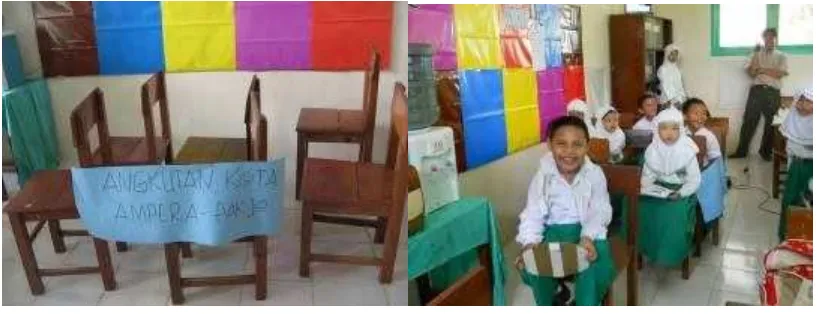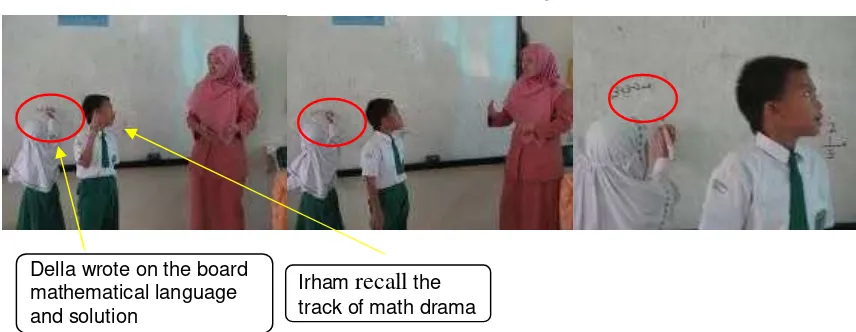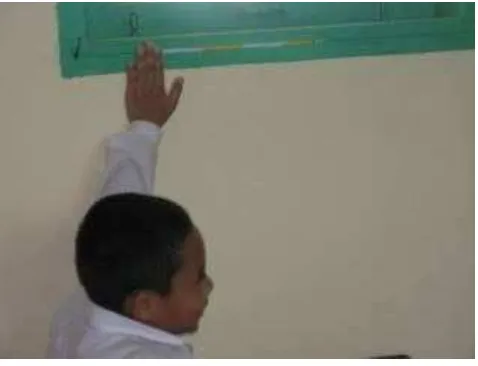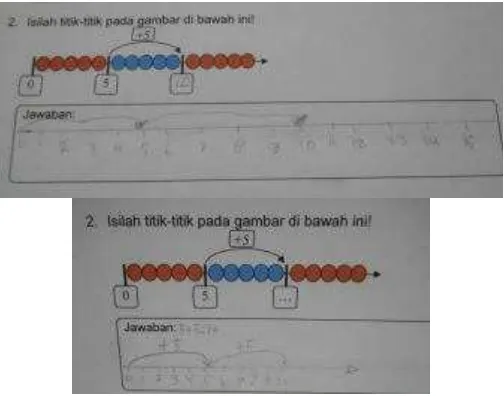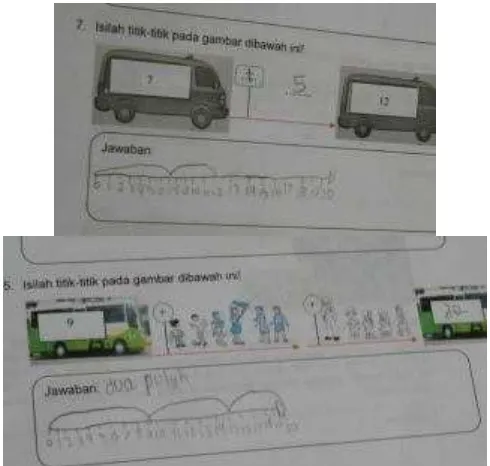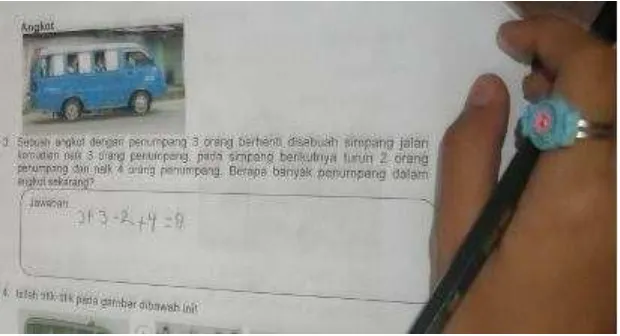67
The Indonesian’s Road Transportations as The Contexts to Support
Primary School Students Learning Number Operation
Kairuddin, Darmawijoyo
Abstract
This paper highlights the Indonesian’s road transportation contexts, namely, angkot, that used in learning and teaching of addition and subtraction in first grade and second grade MIN-2 Palembang. PMRI approach that adopt from RME was used in this design research. From teaching experiment was founded that the student used many strategies when teaching and learning process conducted. In situational level they used their knowledge of experience-base activity, in referential level they use manik-manik (string of beads), and in general level they used number line to solve the problem. From the research was known that the Indonesian’s road transportation context helps student to understand basic concept of addition and subtraction. The suggestion to further research this context can be used in design research of multiplication.
Key word: Indonesian’s road transportation, angkot, context, addition, subtraction
Abstrak
Tulisan ini dimaksudkan untuk menginvestigasi konteks taransportasi angkutan darat yaitu angkutan kota (angkot) yang digunakan dalam pembelajaran penjumlahan dan pengurangan pada kelas 1 dan kelas 2 MIN-2 Palembang. Pendekatan Pendidikan Matematik Realistik yang diadopsi dari Realistic Mathematics Education (RME) digunakan dalam design research ini. Dari penelitian didapat bahwa siswa menggunakan banyak strategi ketika proses pembelajaran dilaksanakan. Dalam level situasional (kontekstual) siswa menggunakan aktivitas berdasarkan pengalaman, dalam level refrential siswa menggunakan manik-manik, dalam level general siswa mengguanakan garis bilangan dan dalam level formal siswa menggunakan pengetahuan yang sudah ada untuk menyelaesaikan soal yang diberikan. Dari penelitian ini didapat kontek angkot memebantu siswa untuk memahami konsep dasar dari penjumlahan dan pengurangan. Penelitian dapat dilanjutkan dengan meneliti konteks angkutan darat ini untuk topik perkalian.
Kata kunci: Angkot, Konteks, Penjumlahan, Pengurangan
Introduction
PMRI, has started a decade ago (Sembiring, Hoogland, & Dolk, 2010; Ekholm, 2009). Utilizing a bottom-up approach, this movement started in primary schools involving groups of mathematics educators and primary school teachers.
The RME theory was build upon the Freudenthal argument that mathematics is a human activity, an activity of mathematizing whether subject matter from everyday life reality or mathematical matters (Armanto, 2002).
It has been examined that children first learn addition principle through context and physical object then gradually generalize using symbolic problem (Gilman & Gallistel, 1978). Giving children a rich contextual study environment will help them to construct the concept of addition and subtraction.
Indonesia is a big and large country that has many contexts. odong-odong,ojek, and angkutan kota (angkot) are the contexts that can be found in every place in Indonesia, special for angkot, this transportation used by most of village and city inhabitants as transportation to go to any where. Angkot problem offers the student opportunities to develop a formal mathematical language. The teaching started with a real life situation in which the student have to act as the driver of angkot. The passengers are getting on and off the angkot, and each stop the student have to determine the number passengers in the angkot.
Variety of Context
At the primary level it is common to see this kind of context that is “close to the student” and taken from his or her “daily life”. As students progress to the upper grades, the role of context often decreases and when it does occur, it is often as less familiar context drawn from the sciences or another discipline studied in the school curriculum. The exact role of context and its impact on student performance in assessment settings is not known. The use of items within context raises questions about differential student opportunities to learn the context interpretation skills. At the same time, the use of context situates the student assessment as close as possible to the real world contexts in which the student will be expected to make use of the mathematical content and modeling processes. According to Jan de lange (1987), there are four variety of contexts:
2. Educational and occupational contexts include problem situations that students might confront while at school, including those rather artificial problems designed specifically for teaching or practice purposes, or problems that would be met in a work situation.
3. Public contexts are those situations experienced in one’s day-to-day interactions with the outside world.
4. Scientific situations are more abstract and might involve understanding a technological process, theoretical situation or explicitly mathematical problem.
Five Tenets of Realistic Mathematics Education
The process of designing a sequence of instructional activities that starts with
experience-based activities in this research was inspired by five tenets for realistic mathematics
education defined by Treffers (1987) that are described in the following ways:
1. Phenomenological exploration
As the first instructional activity, a concrete context is used as the base of mathematical
activity. The mathematical activity is not started from a formal level but from a situation
that is experientially real for students. Consequently, this research employed Indonesian’s
road transportation (angkot) as the contextual situation.
2. Using models and symbols for progressive mathematization
The second tenet of RME is bridging from a concrete level to a more formal level by
using models and symbols. Students’ informal knowledge as the result of
experience-based activities needs to be developed into formal knowledge of addition and subtraction.
3. Using students’ own construction
The freedom for students to use their own strategies could direct to the emergence of
various solutions that can be used to develop the next learning process.
4. Interactivity
The learning process of students is not merely an individual process, but it is also a social
process. The learning process of students can be shortened when students communicate
their works and thoughts in the social interaction emerging in the classroom.
5. Intertwinement
Research Methodology
A classroom teaching experiment was the selected methodology because it allowed researchers to explore and analyze learning possibilities in a class setting. Initially, researchers conjecture regarding the learning process and further articulate learning goals for students. These learning goals are then supported by planning a sequence of instructional tasks (Cobb, 2000).
Studies using Realistic Mathematics Education (RME) helps students develop sophisticated mathematical ways of reasoning through three heuristics: guided reinvention, didactical phenomenology, and emergent modeling. Guided reinvention is the key principle in RME. By placing students in an environment where a particular concept of mathematics was developed, the students are able to “reinvent” the concept themselves (Gravemeijer, 2004).
The second heuristic of RME, didactical phenomenology, focuses on students’ perceptions of mathematical experiences and how these perceptions may create opportunities for learning (Gravemeijer, 2004). Throughout the some-day instructional unit, realistic context problems allowed students to grow mathematically by creating opportunities for the prospective teachers to develop their understanding of number concepts and operations. Initial tasks involving counting and unitizing -supported the development of number concepts that eventually allowed students to compose and decompose numbers. In the end, tasks completed in previous phases supported students’ development of flexible addition and subtraction procedures. In the final heuristic of RME, emergent modeling helps students model their own informal mathematical activity. The aim is that the model with which the students model their own informal activity gradually develops into a model for more formal mathematical reasoning (Gravemeijer, 2004).
Teaching Experiment Use Indonesian’s Road Transportation Context
Figure 1. Angkot seats figure 2. Angkot driver and passenger playing math drama
Then teacher give scenario of math drama:
An angkot has 3 passengers, stop at roadside and get on 3 passengers, after derived then stop at next roadside and get off 2 passengers and get on 4 passengers. Angkot driver want to determine how many passengers in angkot at last stop.
After this math drama teacher asked every group of discussion to discus their strategy to determine the number of passengers in angkot in last stop. Every group tried to use their experience base-activity to find out the number of last passenger. They discussed among of them, the development of mathematical language is elicited by the need to keep track of what happened during the ride of angkot.
Emergent Modeling and Student Strategy During Teaching Experiment
The implementation of the second tenet of RME produced a sequence of models that supported students’ acquisition of the basic concepts of addition and subtraction Emergent modeling is one of the heuristics for realistic mathematics education in which Gravemeijer (1994) describes how models-of a certain situation can become models-for more formal reasoning.
1. Situational level
passenger in the angkot when the passengers get in and get off. There are some student’s strategies when they solve the problems with angkot context.
Figure 3. The discussion of students and the students’ strategy
After they finished discussion teacher ask the student to present their strategy. Irham and Della come to in front of class to present their strategy
Figure 4. Irham and Della presented their strategy
In the student presented their strategy, Irham recall the track of math drama and Della write down the mathematical language and solution on the white board.
Irham: “angkot has 3 passengers”, Della wrote number 3 on the board
Irham: “get on 3 passengers”, Della wrote number 3 on the board, become 3 + 3
Irham : “get off 2 and get on 4 passengers”, Della wrote -2and 4, become 3 + 3 – 2 + 4 = 8
Irham recall the track of math drama Della wrote on the board
From the student’s presentation we look that students can find the solution by used experience base-activity because of the context close to them. When offering the students a learning environment for developing a formal mathematical language that makes sense to them, the angkot context is very suitable to elicit mathematical reasoning.
2. Referential level
The use of models and strategies in this level refers to the situation described in the problem or, in other words, referential level is the level of models-of.
A class discussion encourages students to shift from situational level to referential level when students need to make representations (drawings) as the models-of their strategies and beads as. As an addition, moving beads activity also served as referential activity in which students used beads to represent their way in addition and subtraction. In this activity, the beads become model-of the situation that signifies the iteration of passenger get on and get off angkot.
In class discussion, teacher asked students to present their strategy using beads (figure 5) to know their reasoning in referential level.
Figure 5. Beads String on the wall
Figure. 6 and figure. 7. Adrian used beads as a model and moved them to find out the number of passenger in angkot
Figure 8. Adrian’s last solution
Teacher: “What will you do with according the problem Adrian?” Adrian : “I move 3 beads to left side”
Teacher : “Why do you move 3 beads?”
Adrian : “Because of 3 passenger get on to the angkot” Teacher : “Then…?”
Adrian : “I move again 3 beads to left side” Teacher : “Why you move 3 beads?”
Adrian : “Because there are also 3 passenger get on the angkot” Teacher : “Then…?”
Adrian : “I move 2 beads to right side” Teacher : “Why you move 2 to right side?”
Adrian : “Because there are 2 passenger get of fro angkot” Teacher : “oooo, then…?”
Adrian : “I move 4 beads to left side, because there are 4 passenger get on to the angkot”
Teacher : “How many the passengers on the angkot?” Adrian calculated the number of beads on the left side.
According to this presentation the angkot context evolves to a model to support mathematical thinking. An important requirement for this model functioning in this way is that they are rooted in concrete situation and that they are also flexible enough to useful in higher level of mathematical activities. This means that the model will provide the student with a foothold during the process of vertical mathematization, without obstructing the path back to the source. (Marja van den Heuvel-Panhuizen, 2001)
3. General level
In general level, models-for emerge in which the mathematical focus on strategies dominates over the reference to the contextual problem.
The empty number line could be introduced through a string of beads that alternate in color every 10 beads in a counting activity. The empty number line is emerged first as model-of a situation then it develops as a model-for solving addition and subtraction problem up to 100. They used this tool to solve the problem. The use of the empty number line would now seem to be established as an effective model to support children’s development of mental calculation strategies (Rousham, 2003; Foxman and Beishuizen, 2003). The empty number line offers a perfect tool for expressing the student’s personal reasoning (Koeno Gravemeijer, 2004). An empty number line was found to be a powerful model to do mental arithmetic strategies flexibly. An empty number line is best to represent children’s informal strategies in counting and it has been potential to foster the development of more sophisticated strategies in children (Gravemeijer, 1994).
Figure 10. Student created the empty number line from context to find out the solution
To find out the student reasoning use empty number line as figure 11, the teacher asked the student to present their strategy.
Figure 11. Student use empty number line to find out solution
Teacher : “Who have another strategy?” Hafiz : “Me mam”
Teacher : “Please!”
Hafiz : “First, I draw line from 0 to 3” Teacher : “Why you draw line from 0 to 3?”
Hafiz : “Because there are three passengers on angkot, then I draw line from 3 to 6, that means there are 6 passengers in angkot, then I draw line from 6 to 4”
Teacher : “Why you draw from 6 to 4?”
Hafiz : “I draw line from 4 to 8 because there are 4 passenger get on angkot, so the total passengers at last stop 8 passengers” Teacher: “Ok, thanks, sit down please, let’s give applause to Hafiz”
We see here that the students are able to find and use the empty number line to find solution.
4. Formal level
In formal level, reasoning with conventional symbolizations is no longer dependent on the support of models-for mathematics activity. The focus of the discussion moves to more specific characteristics of models related to the concepts of addition and subtraction.
Figure 12. The student’s solution in formal form
The angkot and the angkot stop contexts are an example of how experiences from a “daily life” situation can be the impetus for growth in mathematical understanding. As became already visible in the previous examples, progress implies that students arrive at more general solutions from context-related solutions.
Conclusion
level possible, the models have to modify from a “model of” a particular situation to a “model for” all kinds of other, but equivalent, situations.
This important role of models has all to do with the level principle of RME. This principle implies that learning mathematics is considered as passing through various levels of understanding: from the ability to invent informal context-related solutions, to the creation of various levels of shortcuts and schematizations, to the acquisition of insight into the underlying principles and the discernment of even broader relationships.
Reference
Armanto, D. (2002). Teaching multiplication and division realistically in Indonesian primary schools: a prototype of local instructional theory. Doctoral dissertation. Enschede: University of Twente.
Brink, J. van den, 1981, Realistic mathematics for young children, CD-Bata Press / Freudenthal Institute.
De Lange, J. 1987. Mathematics, insight and meaning. Utrecht: OW &OC
Fosnot, G. T. (2007). Investigating number sense, addition, and subtraction. Firsthand Heinemann.
Gravemeijer, K. (2004). Regular Lecture, Creating opportunities for Student to Reinvent Mathematics, Freudenthal Institute, University Utrecht, the Netherlands
Gravemeijer, K. (1994). Developing Realistic Mathematics Education. Utrecht: CD Beta Press
Sembiring, R., Hoogland, K., & Dolk, M. (2010). A decade of PMRI in Indonesia. Utrecht: APS.
Van den Heuvel-Panhuizen, M. (2001). Proceedings of The Netherlands and Taiwan Conference on Mathematics Education, Taipei, Taiwan, 19 – 23 November 2001.
